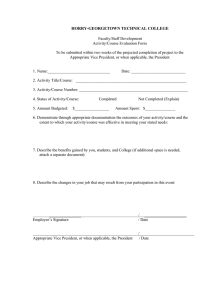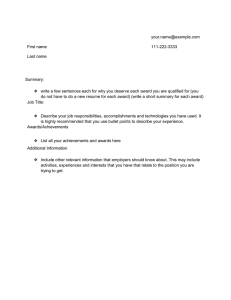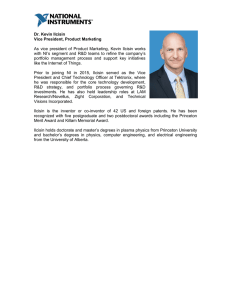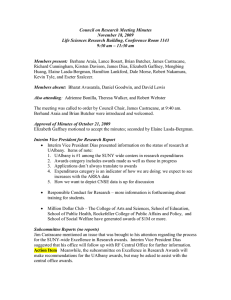Council on Research Meeting Minutes January 27, 2014
advertisement
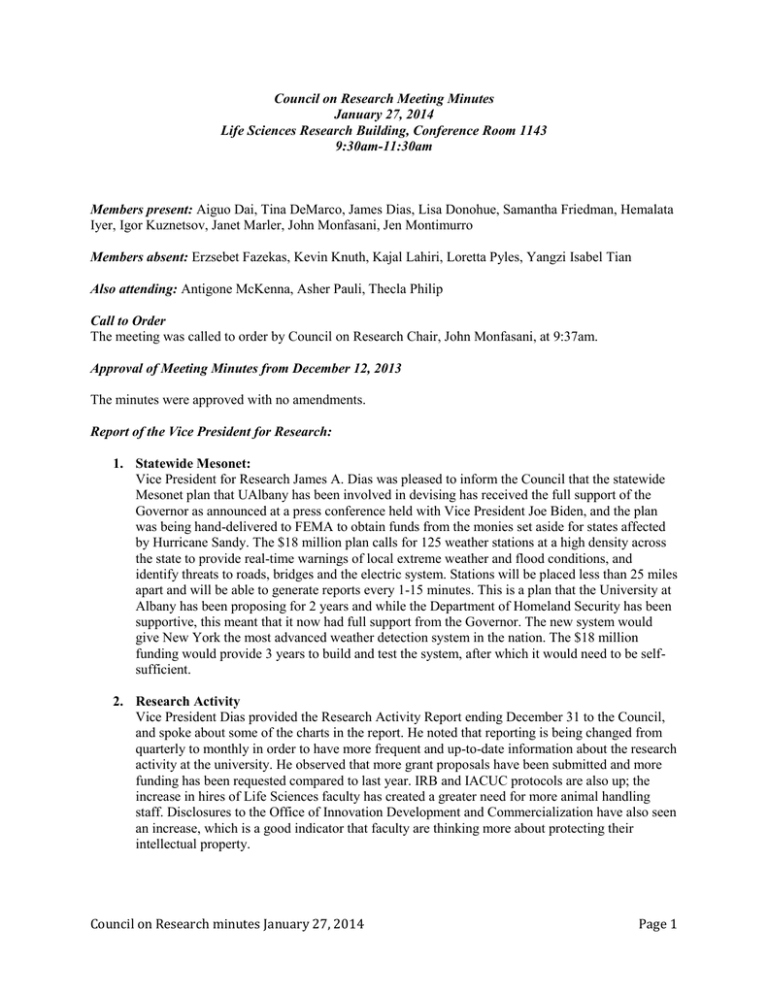
Council on Research Meeting Minutes January 27, 2014 Life Sciences Research Building, Conference Room 1143 9:30am-11:30am Members present: Aiguo Dai, Tina DeMarco, James Dias, Lisa Donohue, Samantha Friedman, Hemalata Iyer, Igor Kuznetsov, Janet Marler, John Monfasani, Jen Montimurro Members absent: Erzsebet Fazekas, Kevin Knuth, Kajal Lahiri, Loretta Pyles, Yangzi Isabel Tian Also attending: Antigone McKenna, Asher Pauli, Thecla Philip Call to Order The meeting was called to order by Council on Research Chair, John Monfasani, at 9:37am. Approval of Meeting Minutes from December 12, 2013 The minutes were approved with no amendments. Report of the Vice President for Research: 1. Statewide Mesonet: Vice President for Research James A. Dias was pleased to inform the Council that the statewide Mesonet plan that UAlbany has been involved in devising has received the full support of the Governor as announced at a press conference held with Vice President Joe Biden, and the plan was being hand-delivered to FEMA to obtain funds from the monies set aside for states affected by Hurricane Sandy. The $18 million plan calls for 125 weather stations at a high density across the state to provide real-time warnings of local extreme weather and flood conditions, and identify threats to roads, bridges and the electric system. Stations will be placed less than 25 miles apart and will be able to generate reports every 1-15 minutes. This is a plan that the University at Albany has been proposing for 2 years and while the Department of Homeland Security has been supportive, this meant that it now had full support from the Governor. The new system would give New York the most advanced weather detection system in the nation. The $18 million funding would provide 3 years to build and test the system, after which it would need to be selfsufficient. 2. Research Activity Vice President Dias provided the Research Activity Report ending December 31 to the Council, and spoke about some of the charts in the report. He noted that reporting is being changed from quarterly to monthly in order to have more frequent and up-to-date information about the research activity at the university. He observed that more grant proposals have been submitted and more funding has been requested compared to last year. IRB and IACUC protocols are also up; the increase in hires of Life Sciences faculty has created a greater need for more animal handling staff. Disclosures to the Office of Innovation Development and Commercialization have also seen an increase, which is a good indicator that faculty are thinking more about protecting their intellectual property. Council on Research minutes January 27, 2014 Page 1 Committee Reports 1. Excellence in Research Awards Committee Three faculty members were nominated for the President’s Award for Excellence in Research and Creative Activities, and after thoroughly reviewing the nomination materials the committee felt that two of the faculty should be supported for the awards: Charles Hartman and Igor Lednev. The committee chair, John Monfasani, did express concern that the numbers nominated are low, and people need to be encouraged to nominate faculty for this award. Feedback has been noted that there is a significant amount of work required to nominate faculty members for the award, however, the requirements are aligned to the requirements of the Chancellor’s award and similar to the requirements of national awards and society memberships, which faculty are encouraged to be pursuing. It was noted that if nomination packets are put together for the Excellence awards, they then have the materials necessary to go forward for national recognition. New Business 1. Professor Jennifer Manganello, Provost’s Fellow- Research Survey and Researchers’ Liaison Committee Jennifer Manganello discussed the research practices survey that she’s planning to send out to faculty over the coming weeks in order to obtain faculty feedback on the support they receive for their research and creative endeavors. It was generally agreed that it would be best to send the survey out early in the semester to maximize the likelihood of getting as many people as possible to respond, and it was also determined that it would be best if the email came from the Vice President for Research, as there was a higher likelihood people would open an email from him rather than one from a colleague they may or may not know. Jennifer noted that the University of South Florida, which had faculty do a similar survey, obtained a 20% response rate; it’s hoped that a higher percentage of UAlbany faculty will respond to this survey. Logistical details were discussed such as setting a deadline of one month and doing weekly reminders, as well as determining that Friday was probably the best day of the week to send this in order to obtain the best response. Vice President Dias informed the Council that Dr. Manganello has been sending recommendations in a one-page format to his office, and it was agreed that these would be of interest to the Council and should be shared for the next meeting (action). Jennifer Manganello and Researchers Liaison Committee chair Jennifer Montimurro also raised the issue of the role of the Researchers Liaison Committee for discussion. As described in the subcommittees list, the role of the RLC is to “Consider improvements to the campus procedures related to grants management. Provide recommendations to the Vice President for Research, via COR, on methods to improve investigators’ capacity to efficiently apply for external funding and manage grants received.” Unlike the other committees, which generally relate to award programs, it does not have a clear agenda of specific issues to address. A discussion ensued which generally settled on the role of the committee as addressing issues which were more long-term and affected the broad university community, rather than issues individual PIs are facing, for instance. It was proposed that a system similar to the ITS helpdesk could be set up through the Division for Research website for faculty to send queries or issues to the Office of the Vice President for Research, which would triage the queries and if applicable might send them to the Researchers Liaison Committee. That way it might be possible to create a database to track the types of queries being submitted to the VPR Office. Council on Research minutes January 27, 2014 Page 2 A number of suggestions of tasks that the committee could address included: Creating an asset map of research resources on campus, with notes about whether resources were available for shared use Sustaining engagement with communities in which research is conducted, so that researchers don’t feel they’re turning their backs on the communities once they’ve collected their data Compliance issues Finding ways to encourage faculty or creating incentives for obtaining research grants Informing faculty of the research tools and infrastructure that already exist on campus 2. Absenteeism Chair John Monfasani noted that absenteeism seems to be high this year. It was noted that Erszebet Fazekas has not attended any of the meetings of the Council on Research, and unanimous approval was given for Chair Monfasani to find a replacement member of the Council. 3. Calendar for FRAP A awards Due to scheduling issues the FRAP awards committee will meet the first week of February, and will have recommendations both for award recipients and for the guideline revisions for the Council on Research meeting February 21st. Council on Research minutes January 27, 2014 Page 3
